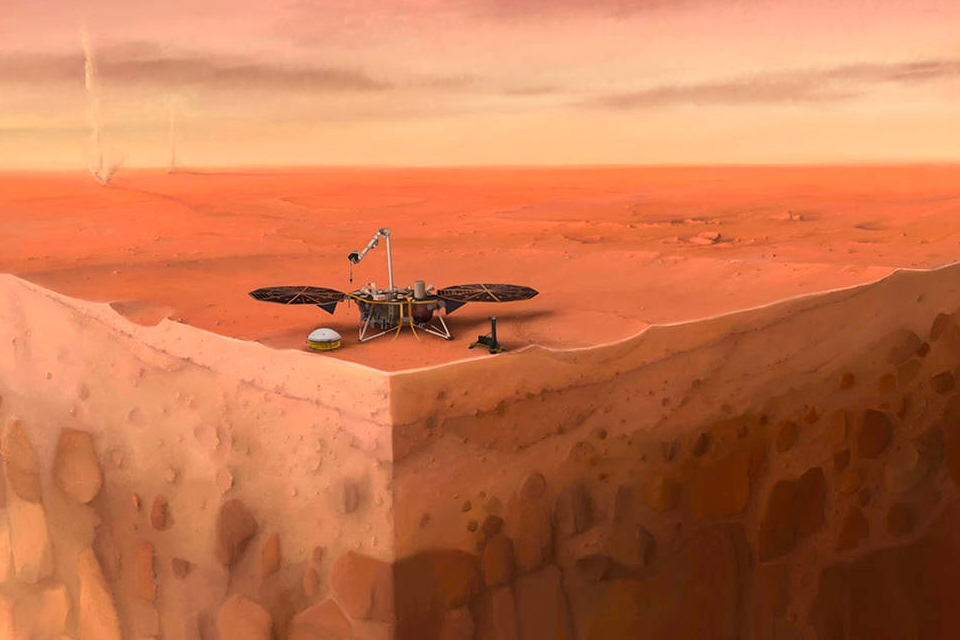After nearly a year of worry, it has been decided to retire the Marslander InSight drill.
After rovers and orbiters already mapped the surface and atmosphere of the red planet, NASA launched a Mars lander in 2018 that would conduct research deep below the surface for the first time. A sensor-equipped drill would be hammered several feet into the Martian surface and measure the heat coming from the interior of the planet. And this would allow researchers to gain more insight into the evolution and composition of the red planet.
It’s finished
But those ambitious plans have now died a silent death on Mars. NASA has announced that it will stop all attempts to chase the drill under the Martian soil.
The news does not come as a complete surprise. In recent months, NASA has repeatedly stated that there were problems with the drill. Or more precisely: that the drill has problems with the Martian soil (see box).
The drill – part of an instrument fully referred to as the Heat Flow and Physical Properties Package – was designed by the German aerospace organization DLR. In the design of the drill, the researchers had assumed that the Martian soil would offer some resistance, but the soil around InSight does not do enough, so that the drill does not go deeper, but moves more sideways (just like a ‘normal’ drill on Earth does if you don’t push it hard enough on the surface you want to drill). In the past two years, everything has been done to hammer the drill – also known as ‘mole’ – deeper into Mars. For example, InSight’s robotic arm was used to limit the lateral movements of the drill. And recently NASA ordered the robotic arm to throw some loose soil on the slightly dug-in drill and tamp it down, in the hope of creating the necessary friction. But it was – it turns out – all in vain.
Incompatible
Last week, NASA made a last-ditch effort, attempting to drive the drill underground with another 500 hammer blows. But when it failed again, the researchers decided to give up. “We’ve given everything, but Mars and our heroic mole are proving incompatible,” said DLR researcher Tilman Spohn.
InSight continues
Although the drill has now been said goodbye, Marslander InSight’s mission is continuing. There are several other instruments on board the lander that will conduct research on the red planet at least until December 2022. For example, InSight has a seismometer that has already registered more than 480 Marsquakes. In addition, an instrument can be found on board the lander that can reveal whether the core of the red planet is liquid or solid. In addition, the lander has weather sensors that gather the most detailed meteorological data ever gathered on Mars.
Legacy of the drill
It’s unfortunate that InSight’s drill failed to collect the data researchers were hoping for. But it is certainly not the case that this failure on Mars does not benefit us at all, Spohn emphasizes. “Fortunately, we have learned a lot, which will come in handy on future missions where we will try to get below the surface of Mars.” In addition, the problems with the drill forced NASA to be creative with the robotic arm and use it for interventions that were not planned in advance. This has made researchers much more useful with the robotic arm and that will come in handy soon. NASA is planning to dig in the cable connecting the seismometer resting on the surface of Mars to the Mars lander, using the robotic arm. It is hoped that the cable will then undergo less temperature fluctuations. These temperature fluctuations cause noise in the seismic data.
Finally, the unfortunate adventure of the drill has also yielded more information about the Martian soil. Why the soil just below the surface on which InSight rests has such unexpected properties is still unclear. It is a mystery that researchers expect to ponder for a while yet.
–
Keep amazed ✨
Receive the most beautiful space photos and interesting popular science articles every Friday. Get the free Scientias Magazine together with 50,000 others.


